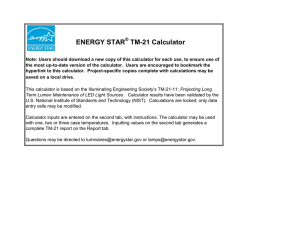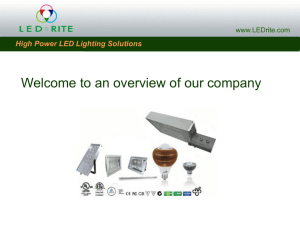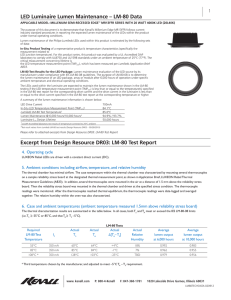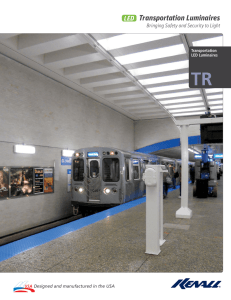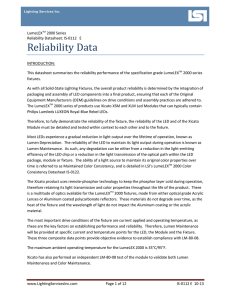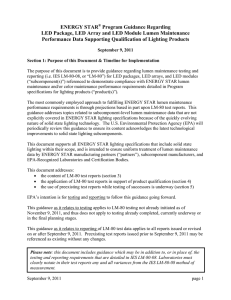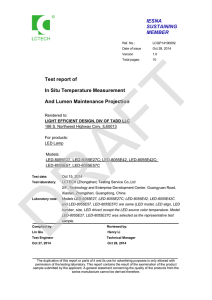making sense of led testing standards
advertisement
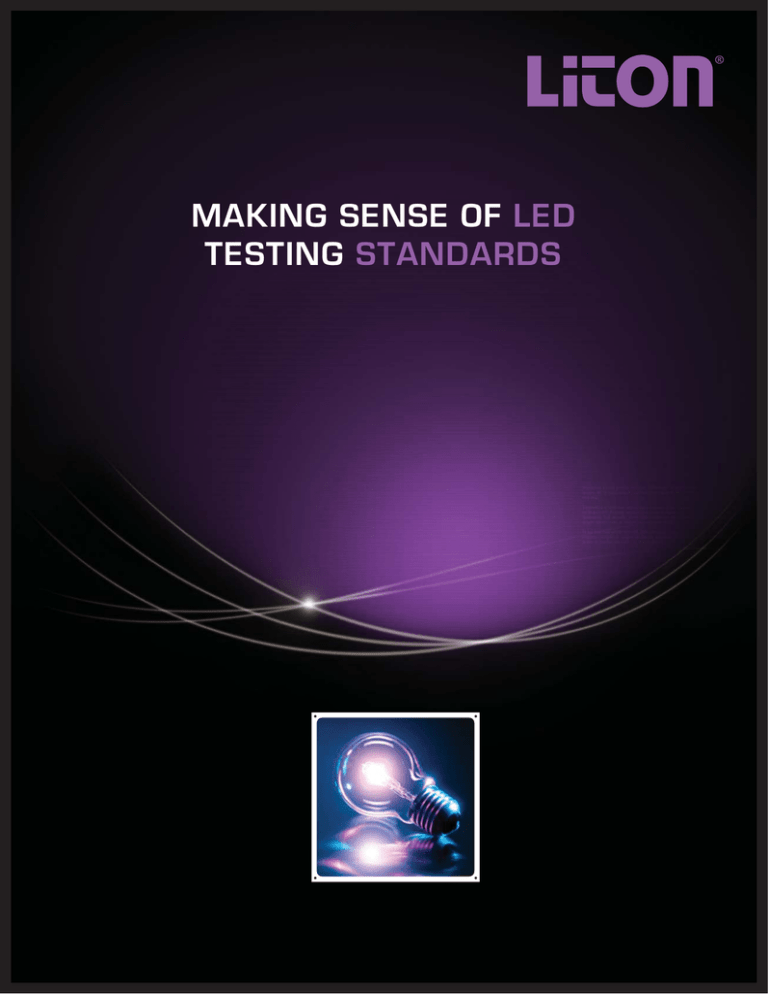
MAKING SENSE OF LED TESTING STANDARDS MAKING SENSE OF LED TESTING STANDARDS What are LM-79, LM-80, TM-21 and L70? LM-79, LM-80, TM-21 and L70 are letters and numbers used to describe testing standards for LED performance that are becoming the jargon of our lighting industry. Unfortunately, these are also codes that are frequently misused, misunderstood and misapplied. Standards were created by the IESNA to specify common LED testing and reporting procedures to be used when comparing one LED product to another. What follows here is a brief and hopefully simple explanation of what these standards actually mean and how to apply the information to the LED purchasing decision. First, it is important to note that these standards are not performance requirements as in: ‘An LED fixture must output XX lumens to meet a requirement’. Instead, these standards apply to testing and reporting procedures that allow comparison of products from different manufacturers using equivalent data. Photometric & Electrical Standards LM-79: A standardized method for photometric and electrical measurements of LED products. As written, the standard measures the total light output of general illumination fixtures but not the beamspread or field angle. Photometric LM-79 measurements apply to the LED: 1. Lumens generated or delivered. 2. Correlated Color Temperature (CCT) or Kelvin Temperature (ie: 3000K). 3. Color Rendering Index (CRI). Ex: 80CRI Electrical LM-79 Measurements: 2 1. Input AC Power 2. Input voltage frequency. 3. Power factor A DIVISION OF EEMA LIGHTING GROUP • 5461 WEST JEFFERSON BLVD., LOS ANGELES, CALIFORNIA • PH: 323.904.0200 (1 800 515 4880) FAX: 323.904.0201 (1 800 972 4880) MAKING SENSE OF LED TESTING STANDARDS Lumen Maintenance LED emitters do not actually burn out the way that other lamp types such as Incandescent or MR16 lamps do. Instead, they fade to a point below a usable level of intensity. Therefore, the concept of ‘lamp life’ has been replaced by ‘lumen maintenance’ for LED. LED lumen maintenance is typically reported as a total number of hours defined by an ‘L’ number (ex: L70). L70: Lumen maintenance is a prediction of the number of hours an LED will operate before it fades below a useful level of intensity. Currently, lumen maintenance reporting assumes that dropping below 70% of initial lumen output is the end-of-life for the emitter. Hence, L70 predicts when the LED reaches 70% of initial lumen output. LM-80: A standard that specifies test conditions and methods of measurement for determining the useful life span of an LED package, array or module. 1. The test requires a minimum of 6,000 hours of observation with performance data collected every 1,000 hours and documented in a LM-80 report. (see figure 1.) 2. The standard does not specify pass/fail criteria. 3. The standard does not extrapolate the collected data beyond 6,000 hours. Consequently, it cannot be an accurate measure of lumen maintenance beyond 6,000 hours or a measurement of the accuracy of LM-70 reports beyond the testing period. 4. Liton uses high quality LEDs in all of its LED lighting fixtures from manufacturers including Cree, Nichia, Bridgelux, Edison-Opto and Philips and uses the LM-80 lumen maintenance data provided by these respected LED manufacturers. TM-21: Is a method for forecasting long-term lumen maintenance of LEDs beyond the 6000 hours of testing that LM-80 documents. Most of Liton’s L70 estimates are based on TM-21 (see figure 1.) LM-80 only tests to 6,000 hrs. 1.0 Extrapolated TM-21 Data 1,000 L70 = 50,000 hrs. 5,000 4,000 0.8 3,000 0.9 2,000 Normalized Light Output Figure 1. 6,000 50,000 Hours A DIVISION OF EEMA LIGHTING GROUP • 5461 WEST JEFFERSON BLVD., LOS ANGELES, CALIFORNIA • PH: 323.904.0200 (1 800 515 4880) FAX: 323.904.0201 (1 800 972 4880) 3 MAKING SENSE OF LED TESTING STANDARDS © 2012 LITON LIGHTING • A DIVISION OF EEMA LIGHTING GROUP
